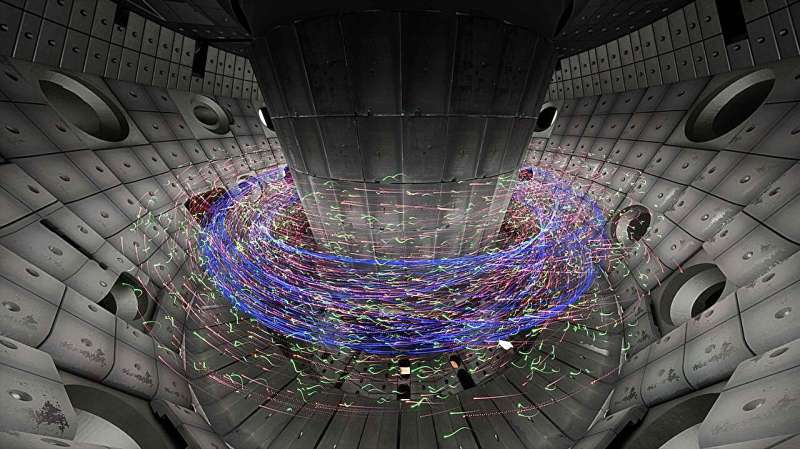This article has been reviewed according to Science X's editorial process and policies. Editors have highlighted the following attributes while ensuring the content's credibility:
fact-checked
trusted source
proofread
3D visualization brings nuclear fusion to life

When it comes to promising forms of energy, nuclear fusion checks all the boxes: it's clean, abundant, continuous and safe. It's produced when the lightweight nuclei of two atoms fuse together to form a heavier nucleus, releasing large amounts of energy in the process.
For fusion reactions to occur in a controlled manner, huge reactors are needed in the form of giant rings, which are filled with magnets to create magnetic fields where atomic particles buzz around and dance like a swarm of bees. Hard to picture? The good news is that you can now view a live simulation of this kind of reactor—called a tokamak—thanks to stunningly realistic 3D visualization technology.
At EPFL, the Laboratory for Experimental Museology (EM+) specializes in this technology and has developed a program that turns the terabytes of data generated from the tokamak simulations and testing carried out by EPFL's Swiss Plasma Center (SPC) into an immersive 3D visualization experience.
For the general public, the visualization is a journey into a ring of fireworks illustrating a possible future source of energy; for scientists, it's a valuable tool that renders the complex phenomena of quantum physics tangible and helps them grasp the results of their calculations.
Images so precise they show wear and tear
The 3D visualization—a panorama measuring 4 meters high and 10 meters in diameter—is a faithful reproduction of the interior of EPFL's variable-configuration tokamak (TCV), rendered in such stunning detail that it rivals even the best-quality gaming experience. The experimental reactor [CS1] was built over 30 years ago and still the only one of its kind in the world.
"We used a robot to generate ultra-high-precision scans of the reactor interior, which we then compiled to produce a 3D model that replicates its components right down to their texture," says Samy Mannane, a computer scientist at EM+. "We were even able to capture the wear and tear on the graphite tiles lining the reactor walls, which are subject to extremely high temperatures during test runs of the TCV."
SPC engineers provided equations for calculating exactly how the quantum particles move at a given point in time. The EM+ researchers then incorporated these equations, along with reactor data, into their 3D visualization system. The catch is that all the calculations have to be carried out in real time.
"To produce just a single image, the system has to calculate the trajectories of thousands of moving particles at a speed of 60 times per second for each eye," says Mannane. This hefty number-crunching is carried out by five computers with 2 GPUs each that EM+ acquired for this project.
The computers' output is fed into the panorama's five 4k projectors. "We were able to build our system thanks to advances in infographics technology," says Sarah Kenderdine, the professor who heads EM+. "It would've been impossible even just five years ago."
The result is realistic images of mind-blowing quality. You can see the injection device that deposits particles into the tokamak as well as the graphite tiles capable of withstanding temperatures of over 100 million degrees Celsius.
And the scale of all this is impressive. To give viewers an idea, the visualization includes an image of a human being—the reactor is roughly twice their size. As the simulation ramps up, the viewer feels quite small as thousands of particles zip by, spinning and twirling and chasing each other. Electrons are in red; protons are in green; and blue lines indicate the magnetic field. Users can adjust any of the parameters to view a specific part of the reactor at a chosen angle, with almost perfect rendering.
SPC director Paolo Ricci explains, "Visualization techniques are fairly advanced in astrophysics, owing largely to planetariums. But in nuclear fusion, we're just starting to use this technology—thanks notably to the work we're doing with EM+."
Drawing on SPC's excellence in this area, EPFL is taking part in the International Thermonuclear Experimental Reactor (ITER) project and is a key member of the EUROfusion consortium. In fact, EPFL was chosen to house one of the consortium's five Advanced Computing Hubs, giving the researchers involved in this project an advanced tool for visualizing their work.
Combining output and art
Kenderdine says the biggest challenge was to "extract tangible information from such a huge database to produce a visualization that's accurate, coherent and 'real'—even if it's virtual. The result is extraordinary, and I would even say beautiful, and it gives scientists a useful tool that opens up a range of possibilities."
"The physics behind the visualization process is extremely complicated," says Ricci. "Tokamaks have many different moving parts: particles with heterogenous behavior, magnetic fields, waves for heating the plasma, particles injected from the outside, gases, and more. Even physicists have a hard time sorting everything out.
"The visualization developed by EM+ combines the standard output of simulation programs—basically, tables of numbers—with real-time visualization techniques that the lab uses to create a video-game-like atmosphere."
Provided by Ecole Polytechnique Federale de Lausanne




















